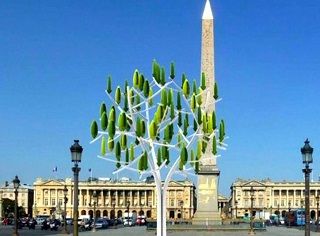Small Wind Power – An Artistic Stab

Claim: It’s quiet but powerful. (Define “powerful.” I’m sure it’s quiet, and I suppose you could say that it’s powerful in the sense that it generates more electricity than a real tree.)
Claim: It needs only half the wind of traditional turbines. (…to start spinning? Possibly true, but irrelevant.)
Claim: They cost $37,000, but could pay for themselves in two years (define “could.” This won’t happen unless they’re almost 100% subsidized, as this device will have a very poor energy return on investment.)
Claim: The device will not kill birds (True. In fact, these turbines will extract so little energy from the wind that they won’t harm mosquitoes, either.)
Claim: The company hopes to mass produce them by early 2016 (Define “hope.” Before I was married, I hoped that Anna Kournikova (see below) would somehow meet me and fall madly in love with me. Trust me on this, I really did. The fact that it did not happen does not render it any less sincere as a “hope.”)


The projected cost is $37k, not $370k. (Note: OMG, you’re right; I fixed that. -Craig) No one should expect this to be a game changer, but it might be interesting.
A French team of engineers constructed a 26 ft. prototype after three years of research and development.
Jérôme Michaud-Larivière is the founder of the Parisian start-up which will market the Wind Tree. He states that the tree – which has not yet been tested by an independent laboratory – is profitable after winds of 7.8 mph on average over one year. The tree can reportedly generate power on winds of just 4.5 mph. Gizmag says, “Its power output is calculated at 3.1 kW.”
Michaud-Larivière hopes the tree can be used to exploit air currents flowing into town along the buildings and streets to feed, for example, LED street lamps.
Here’s a link to the company website: http://www.arbre-a-vent.fr/Actualites_30.html
OMG, you’re right about the cost; let me fix that.
Another issue here is wind resource; if they build this in Paris among all those (stunning) buildings, monuments, etc. they will get very little wind–certainly nowhere near 7.8 mph on average.
Having said this, I probably shouldn’t have written this post. I used it largely to cut up, and I probably should have thought better of it.
Another point to be made is that I don’t object to wind and solar whose aim is clearly not aimed at being financially viable, but merely makes the point that we favor renewable energy in general. I try to communicate this often, e.g., http://2greenenergy.com/2013/05/29/cute-little-wind-turbine/.
Cameron,
Your quoting the company doesn’t really disprove Craig’s point here. If they’re expecting 3.1 kW of average power, then an entire year would produce 27 MWh, which is worth ~$1000 – $2000 here in America. If you were to build one as a residential energy consumer, the value of the energy produced would increase to ~$3250.
That’s still a very poor ROI.
I do like the sentiment, and I strongly feel that art is worthy to invest in for the sake of art… and people should feel free to invest in whatever makes them smile. But the company shouldn’t claim there would be a rapid payback on something like this. There couldn’t be.
And, if I were pursuing this further on a mathematical basis (which I had decided not to do I just saw this just now and said “what the heck”), I would point out that 3.1 kW is its nameplate capacity. The capacity factor of this device at ground level in an urban environment is not going to be impressive. The inventor claims that the buildings will funnel the wind like a shroud, but I find that extremely hard to believe.
My intent was not to disprove Craig’s point (apart from the projected price correction) – merely to provide additional info for those who are interested.
If attractive artistic installations can be installed that will power walkway lighting in an appropriate urban setting, I see no issue with that, particularly if the ROI is on the order of two years and the life is over five years. Please note that I never thought of this as a major solution, merely a potential distributed generation option.
As to the claims of the make and its engineers, they will either be borne out, or they won’t.
Too bad about Anna. 🙂 Talk with you soon.
Yes, it was a most sincere “hope” on my part. 🙂